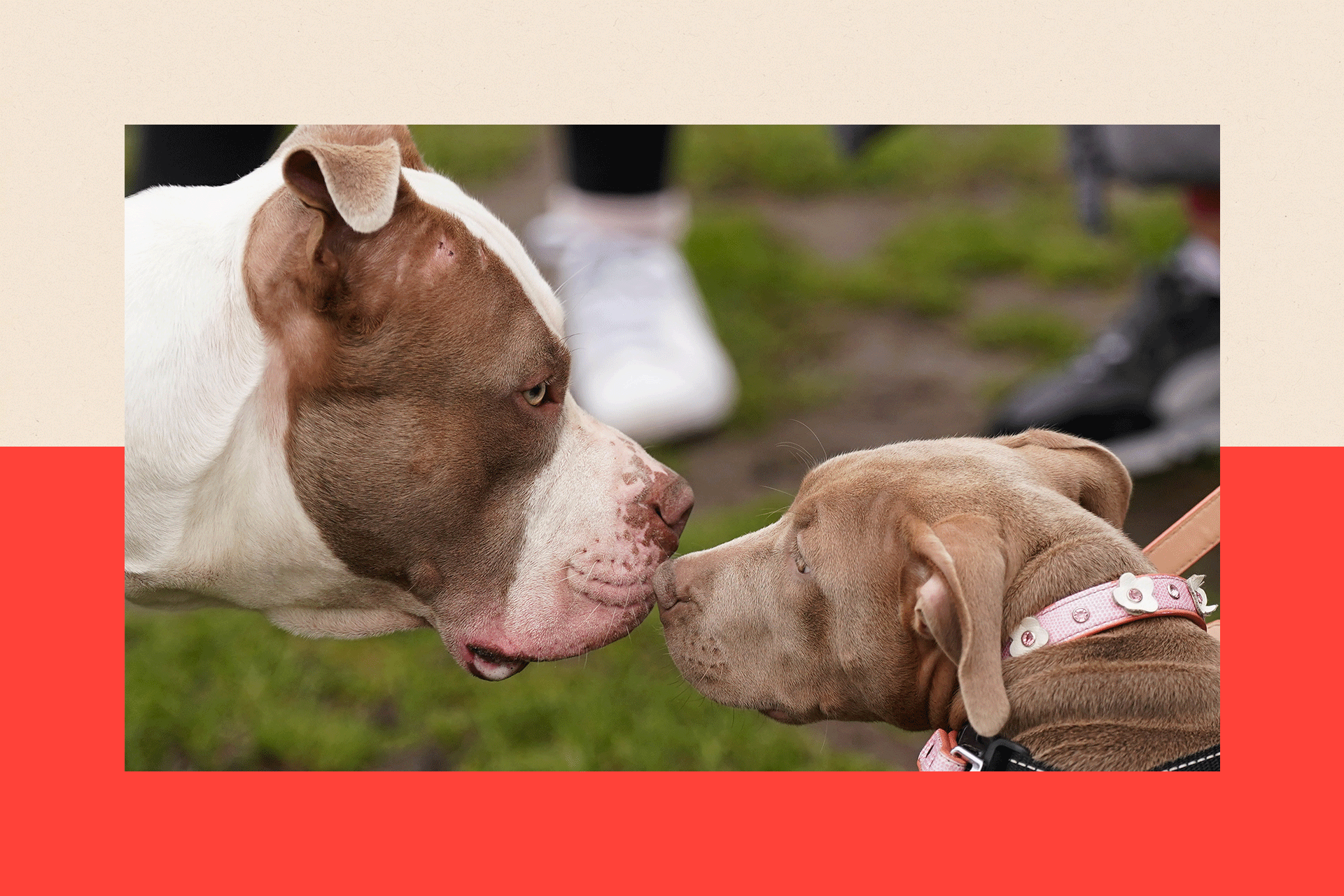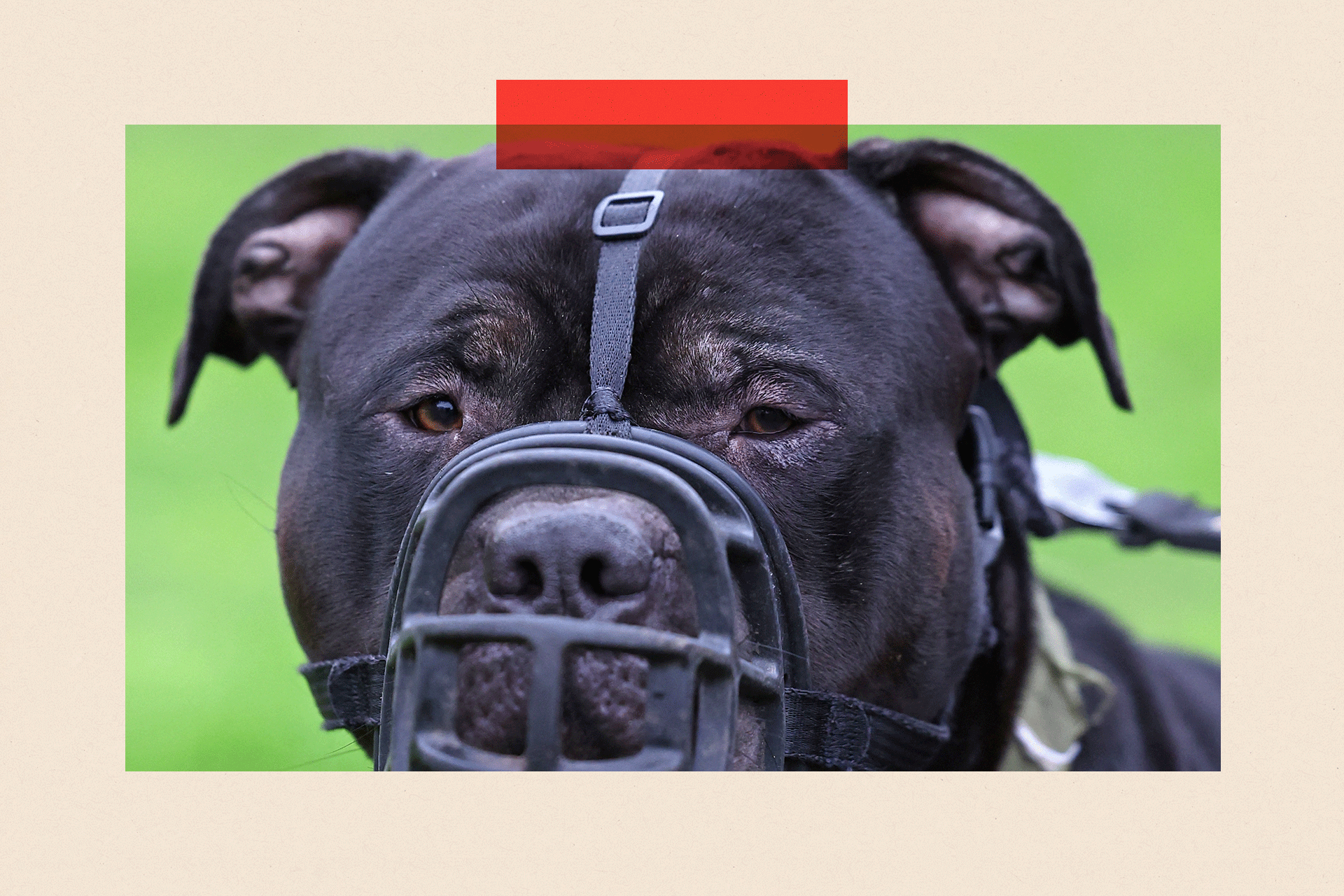
Michael Carpenter was packing up after a camping trip in the Leicestershire countryside with a big group of friends earlier this year, when a woman in his party realised she'd lost her car keys. He said he'd help her find them.
As they searched around her car, Michael says that her dog - which had been sitting inside on the passenger seat - jumped out of the window and bit him.
"I hit it and it ran round and attacked me again," says Michael. "I tried to kick it again, lost my balance and then the owner managed to call it back - I'd be dead if that hadn't happened."
It was, he believes, a banned XL bully dog.
Michael, who is 58 from Birmingham, says he went to hospital where he was x-rayed and given a tetanus injection, and though he reported it to police he decided not to pursue it.
Instead, he shared what happened via Your Voice, Your BBC News, concerned about the levels of irresponsible dog ownership in the country - and the number of attacks despite the XL bully ban.

Michael Carpenter recalls a dog attack: 'The owner managed to call it back - I'd be dead if that hadn't happened'
In all, there were 31,920 dog attacks on people recorded in England and Wales in 2024 - a 2% increase on 2023, according to Freedom of Information figures obtained from police forces. And this may not even show the full picture, as three police forces did not provide useable data.
All this is despite the XL bully ban that came into force in February 2024.
The ban was intended to help reduce the number of people injured by dogs, only the overall figures have continued rising.
Part of the problem is just how divisive this issue is. The sheer level of polarity makes agreeing on a solution extremely difficult - as does the highly emotional nature of the debate.
On one side are people who say they're vilified for loving their pet which, they claim, poses no greater risk than any other dog if trained properly. On the other, campaign groups including Bully Watch are adamant that bully-type dogs present a much bigger risk than other breeds.
What unites almost everyone we spoke to, however, is an agreement that the status quo isn't currently working.
Plastic surgeon: 'The ban changed my life'
Vivien Lees is the anomaly. She works as a plastic surgeon in Manchester and is one of the only people we spoke to who believes the current system is working.
Some of her patients are victims of bad dog attacks. Speaking about the XL bully ban back in April, she said: "We're still seeing serious injuries but some of the worst ones have been less common".

Breeding of XL bullies (pictured), as well as cavapoos and other so-called designer dogs spiked during the Covid-19 pandemic
The same thing happened, she said, when the original Dangerous Dogs Act (that banned four other dogs) was introduced back in 1991.
At the time Prof Lees, who is now vice-president of the Royal College of Surgeons, was a junior surgeon. She recalls seeing a significant drop in the number of patients with life-changing dog attack injuries.
The original Dangerous Dogs Act "changed my life" as a surgeon, she admitted.
But many others we spoke to believe the law itself is flawed - not only the XL bully ban but the original 1991 law too.
Is the Dangerous Dogs Act flawed?
It was little over two years ago that news of a dog attack on an 11-year-old schoolgirl in Birmingham went viral. Soon after Suella Braverman, who was Home Secretary at the time, announced plans for the XL bully ban.
Ana Paun had gone to the shops with her older sister in the Bordesley Green area of the city when a dog - an American XL bully and Staffordshire bull terrier crossbreed - attacked.
"I was so scared. I was screaming for help but [couldn't] do anything," she told the BBC at the time.
Passers-by wrestled the dog off her but it broke free and chased a man into a petrol station forecourt, setting upon him next. In all, three people required hospital treatment.

Ana suffered arm and shoulder injuries, requiring about eight stitches.
From February 2024, under an amendment to the 1991 Dangerous Dogs Act, it became illegal to own an XL bully in England and Wales unless they had an exemption certificate, which allowed existing owners to keep their pet if they met certain criteria such as microchipping their dog and buying special insurance. Similar rules are also in place in Scotland and Northern Ireland.
The 1991 Act had already banned the ownership of four breeds - the pit bull terrier, the Japanese tosa, dogo argentino and fila brasileiro.
But in legal circles, it has been cited as a case study in badly drafted laws.
The former Prime Minister Boris Johnson wrote in a newspaper column, after leaving office, that the original Dangerous Dogs Act had been "rushed through Parliament and has gone down as a model of atrocious legislation".
"By trying to outlaw types of dogs, rather than the actions of dog owners and dog breeders, the Act ushered in a nightmare world of pseudo-scientific dog eugenics, where officials would use calipers to measure parts of the dog's anatomy to determine the breed," Johnson argued.
Other critics of the law, including some animal charities, have argued it focused too heavily on individual breeds. Adding another breed to this already-contentious legislation was asking for trouble, say some.
Certainly, some of the criticisms of the original law apply equally to the amendment that covers XL bullies - including the point of the view that the most irresponsible owners don't bother to comply with it.

Boris Johnson - pictured with his dog Dilyn - called the Dangerous Dogs Act 'atrocious'
Thousands of pitbull terriers, banned under the original act, are still in the UK.
Even while writing this article, we saw a sizeable XL-type dog being taken on a walk in Leeds city centre, its muzzle pointlessly dangling off its collar despite this being one of the requirements of it being out in public.
Carri Westgarth, professor of human-animal interaction at the University of Liverpool, believes that "simple legislation changes are unlikely to be a quick fix".
She argues that the problem with the laws is the lack of resources to enforce them.
The rules governing dangerous dogs are broadly the same across the UK, however the issue is devolved so there are some differences across England, Scotland, Wales, and Northern Ireland.
A spokesperson for the Department for Environment, Food and Rural Affairs says: "This government remains committed to ensuring that the ban on XL bully dogs is fully implemented and enforced to protect communities from dangerous dogs.
"We have recently reconvened the responsible dog ownership taskforce to explore additional measures to keep people and other animals safe."
Time to reintroduce licences?
Others argue that dog licences should be brought back. The RSPCA supports the idea.
Once up and running, they say, a dog licence scheme would fund more dog wardens and animal welfare officers, plus pay to educate people on responsible ownership.
The history of dog licensing in Britain dates back to 1878 and a system ran in some form until 1987 when it was scrapped across most of the UK due to low compliance and high running costs.
Dogs were also required to wear collars with name tags and owners were fined for non-compliance.

A dog is taken into an ambulance run by the Dog Licence Club in 1939
However, Samantha Gaines from the RSPCA warns caution. Though she backs the scheme overall, she warns that the cost of a licence would need to be set carefully.
"If we were to end up with a fee that is just so significant, we know then that people are not going to pay," she says.
And other animal welfare charities don't believe licencing is a good idea. "Dog licencing is a flawed model - it has been tried and was consequently scrapped by the Government over 30 years ago as it was neither enforceable nor effective," says a spokesperson for the Kennel Club.
Chief Constable Mark Hobrough, who is the National Police Chiefs' Council lead for dangerous dogs, admits that enforcing the XL bully ban is already a challenge. It has, he says, "presented policing with a number of challenges and put immense pressure on resources".
Though he sees the "value" of licensing schemes, he warns: "The realities and logistics would need careful consideration" - in other words, it would add more responsibilities to already stretched forces.
More from InDepth
Ratmageddon: Why rats are overrunning our cities
- Published26 September
The other issue is that no one is quite sure how many dogs there are in the country. The best estimate is around 13 million across the UK (around four million more dogs than previously thought, according to academics at the University of Leeds).
Before the law came into force, various government statements suggested they were expecting around 10,000 XL bullies to be registered. In fact there are now 57,000 on the list - as well as all those unregistered.
Targeting 'designer dog' breeders
Could the solution, then, be to licence breeders themselves? The Dog Control Coalition believes this is more achievable than licensing dogs.
Breeding of certain dog breeds including XL bullies, cavapoos and other so-called designer dogs spiked during the Covid-19 pandemic, with many people breeding them without experience in genetics, health screening or breed temperament.
Some have suggested this led to badly-bred XL bullies flooding the market.
There are different rules in place in each part of the UK regarding the licensing of breeders, mainly focused on those who are breed larger numbers of dogs each year.

The sheer level of polarity makes finding a solution extremely difficult
Expanding this to anyone breeding a dog has been proposed by the Dogs Trust - but again enforcement and cost could prove challenging.
Debbie Connolly, an animal behaviourist who acts as a witness in dangerous dog court cases, believes licensing would only work if properly funded.
"We have police struggling to enforce and respond to dog incidents, huge delays getting to court costing hundreds of thousands in kennelling and police costs," she says.
A 'Highway Code' for dog owners
David Tucker, a retired CPS prosecutor who dealt with numerous horrific cases during his career, has a rather more novel idea. He believes the best solution would be a kind of "Highway Code" for dog owners.
"Dog law in general is an untidy mess." Rules are, he argues, spread over multiple pieces of legislation crossing multiple government departments.
He believes that bringing them together in one code would make them easier to understand - he contacted us through Your Voice, Your BBC News to share his proposal.
But Lily Collins, a 25-year-old dog owner from Redditch, Worcestershire thinks this wouldn't work in isolation.
"I don't think it would make a real difference unless it's part of a much broader strategy that includes education, community support, and more consistent enforcement of the laws and standards that already exist."
She has an XL bully called Doug. "There's a clear divide between responsible and irresponsible owners," she says.
"Unfortunately, from what I've learnt, the irresponsible ones often outnumber those who genuinely take the role seriously."

David Tucker, a retired CPS prosecutor, believes the best solution would be a "Highway Code" for dog owners
Yet Mr Tucker's idea is not entirely dissimilar to the conclusions of a recent government-commissioned study carried out by Middlesex University, which also called for legal requirements for people to have "clean" ownership records.
In cases of legal decisions against dangerous dog owners, it suggested the use of dog behaviour training courses similar to speed awareness courses.
Ms Connolly is also in support of better education, together with government-funded neutering.
"Many owners say they cannot afford training or neutering," she says. "The money currently wasted on the increase in incidents and associated costs would be better spent trying to avoid incidents in the first place."
But muddying the issue is the often totally random nature of dog attacks.
Ultimately, anyone can be bitten. And some of the most serious attacks happen in homes, from a family pet.
What's more, no ban so far has managed to fully stop owners with bad intentions or a poor understanding of their responsibilities.
"Any person can get a dog," Ms Connolly points out. "Any person can breed and sell a dog."
And so "no matter how unsuitable a breed may be for a particular person, someone somewhere will sell them one".
Clarification 7 November: This article has been amended to make clear that the rules on dangerous dogs and breeding are devolved matters with different rules applying in different parts of the UK.

BBC InDepth is the home on the website and app for the best analysis, with fresh perspectives that challenge assumptions and deep reporting on the biggest issues of the day. You can now sign up for notifications that will alert you whenever an InDepth story is published - click here to find out how.
